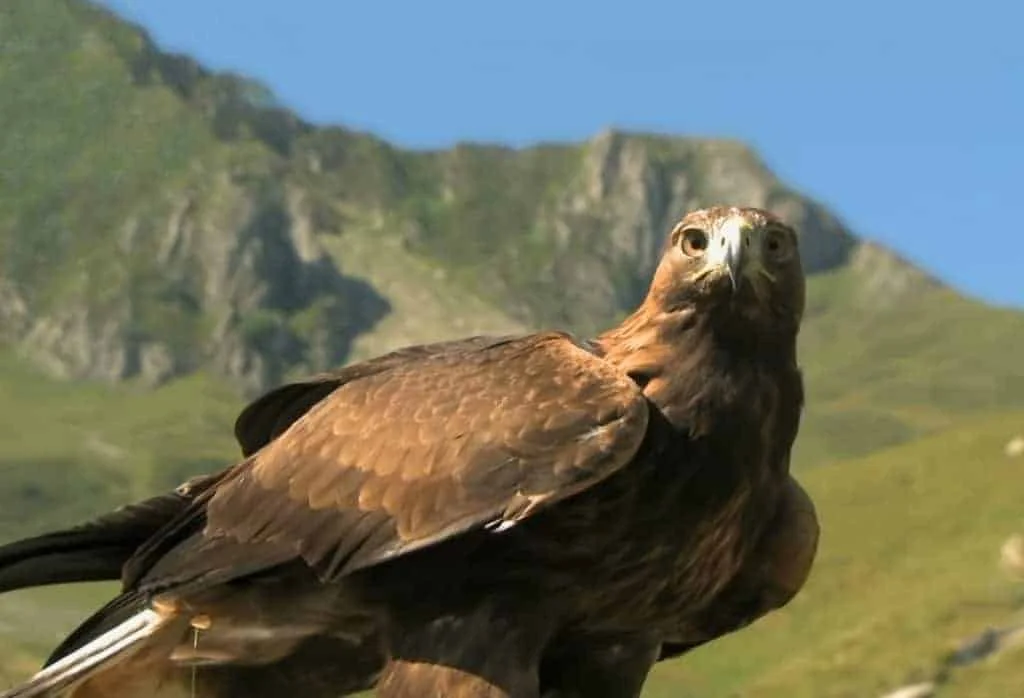In Georgia, it is possible to spot 2 different species of Eagles. These are:
- Bald Eagle
- Golden Eagle
Want to learn more? This book on the Birds of Prey of North America is a fantastic read!
The subtropical southern climate of Georgia is generally too warm for the most prominent North American hunters, who prefer the crisp air near the northwest border.
Fortunately, eagles have made a comeback in the states, largely the result of concentrated efforts in each state to protect their natural habitats.
Georgia took part in efforts by America’s southeastern states to preserve eagles in the mid-90s, and the result is a stabilizing presence of two of the four eagles who visit North America at any given time.
Want to attract birds of prey to your yard? Take a look at our article!
What Eagles can be seen in Georgia?
1. Bald Eagle

America’s national bird has spread throughout the states since conservationist victories kept them alive through the early 2000s.
They seek the uninhabited places of the southeast, such as nature preserves and unprotected mountains that are too wild to tame.
Eagles may rest in places like the Blue Ridge mountains, where their enormous nests can sit on high outcroppings and survey the land for movement.
Or these nests might be on top of the tallest trees, a mound of sticks and earth standing out among the branches.
The eagle’s famous appearance should be easy to identify, from its serious-looking white head, to its powerful brown body and wings, to its long white tail and yellow talons.
A bald eagle’s enormous wingspan is easily visible from the ground, so brave bird watchers need only lookup.
Be wary, though, eagles are fiercely defensive of their nests. They are not averse to scavenging kills made by other animals, though they are as capable as any raptor of killing their own meals.
2. Golden Eagle

Also called the Royal Eagle and King of Birds, one look at the enormous raptor will cast aside any doubt as to why it has such lofty titles.
They trend equal or slightly larger than bald eagles–a large enough bird-of-prey in its own right–with slightly longer, slightly broader wingspans. Its name comes from the light brown feathers on its crown and back, which blend into the dark brown of the rest of its body and appear golden by contrast.
Golden eagles strike at low lying places like marshlands and riparian zones from their mountain perches, where the land itself lays the bait for its prey to gather.
Unlike their bald cousins, these hunters only eat what they hunt, and do not bother with scavenging. Though more reclusive than the bald eagle, a golden eagle is more likely to roost in an abandoned man-made structure if it is tall and walled enough to mimic the mountain’s protection.
They are as territorial as all eagles, with no qualms about swooping down against wolves, cougars, and humans if they perceive a threat to their nests.
Conclusion
While these eagles do prefer the chilly winds of the north, their vacation homes see return visits often enough to give southerners hope.
Unusually cold winters in the north foretell of expected migrations, so it’s a good idea to pay attention to the seasonal reports to get an idea of your chances.
Else, camping grounds near mountains are an ideal starting point. Protected lands have increased the potential eagles can inhabit exponentially over the years, and the inevitable increase that comes from a stabilized population is still ongoing.
This bodes well for bird enthusiasts, conservationists, and watchers alike.
References
- https://www.audubon.org/field-guide/bird/bald-eagle
- https://www.audubon.org/field-guide/bird/golden-eagle

About Us
We are avid bird-watchers who recently retired, allowing us more time to travel the world. Fortunately, we have managed to visit numerous countries around Europe, Asia, and America. Watching and photographing birds has been a passion for many years and we are making the most of the extra time on our hands!
